Navigating Northern Vietnam’s stunning landscapes? SIXT.VN helps you seamlessly connect Cao Bang and Ha Giang for an unforgettable adventure. Discover efficient transport, insider tips, and breathtaking routes. Let SIXT.VN turn your dream journey into reality, optimizing your Vietnam travel experiences with expert guidance and reliable services. Explore Vietnam’s northern gems without the logistical stress.
1. Understanding the Connection Between Cao Bang and Ha Giang
Cao Bang and Ha Giang are two provinces in northeastern Vietnam known for their stunning natural beauty and unique cultural experiences. These provinces, while sharing a border, offer distinct landscapes and attractions, making them ideal destinations for adventurous travelers. The logistical connection between Cao Bang and Ha Giang is crucial for tourists aiming to explore both regions efficiently. Understanding the transport options, road conditions, and travel times is essential for planning a smooth journey. This area’s appeal lies in its combination of natural wonders and cultural richness, appealing to travelers keen on immersive experiences.
1.1. Geographical Overview of Cao Bang and Ha Giang
Cao Bang, famous for its majestic Ban Gioc Waterfall and historical sites like Pac Bo Cave, features diverse landscapes including mountains, rivers, and rice paddies. The province borders China to the north, offering unique cultural influences and stunning scenery.
Ha Giang, known for the iconic Ha Giang Loop, is characterized by dramatic karst mountains, deep valleys, and winding roads. The province is home to numerous ethnic minority groups, each with their own distinct traditions and lifestyles.
1.2. Significance of Logistics for Tourists
Efficient logistics are vital for tourists traveling between Cao Bang and Ha Giang. The remote location and challenging terrain can make travel difficult without proper planning. Reliable transportation, well-maintained roads, and accurate travel information are essential for a safe and enjoyable trip. Good logistics enable tourists to maximize their time, explore key attractions, and immerse themselves in the local culture without unnecessary stress. Effective planning ensures a seamless experience, allowing visitors to fully appreciate the beauty and diversity of these northern provinces.
1.3. Overview of Transportation Options
Several transportation options connect Cao Bang and Ha Giang, each with its own advantages and considerations:
- Motorbike: Ideal for adventurous travelers seeking flexibility and freedom. However, requires experience and caution due to challenging road conditions.
- Private Car: Offers comfort and convenience, especially for families or groups. Allows for customized itineraries and stops along the way.
- Bus/Van: A budget-friendly option for solo travelers. Limited flexibility and can be crowded.
- Combination of Transport: Mixing options like a bus to a central point and then a motorbike for local exploration can balance cost and flexibility.
Choosing the right transportation depends on your budget, travel style, and comfort level. SIXT.VN provides tailored transport solutions to meet diverse needs.
2. Detailed Transportation Routes Between Cao Bang and Ha Giang
Traveling between Cao Bang and Ha Giang offers several scenic routes, each with its unique charm and challenges. Understanding these routes, their conditions, and the estimated travel times is crucial for planning a successful trip. Choosing the right route ensures a safer, more enjoyable journey, allowing you to fully appreciate the beauty of Northern Vietnam. SIXT.VN offers detailed route planning and transport options to suit your preferences and needs.
2.1. Route 1: Cao Bang to Ha Giang via QL4C
- Description: This is one of the most direct routes, taking you through scenic mountain passes and small towns.
- Road Conditions: The QL4C is generally well-maintained, but expect winding roads and some rough patches.
- Estimated Travel Time: Approximately 5-7 hours, depending on stops.
- Key Highlights: Passing through scenic areas like Meo Vac, known for its stunning landscapes.
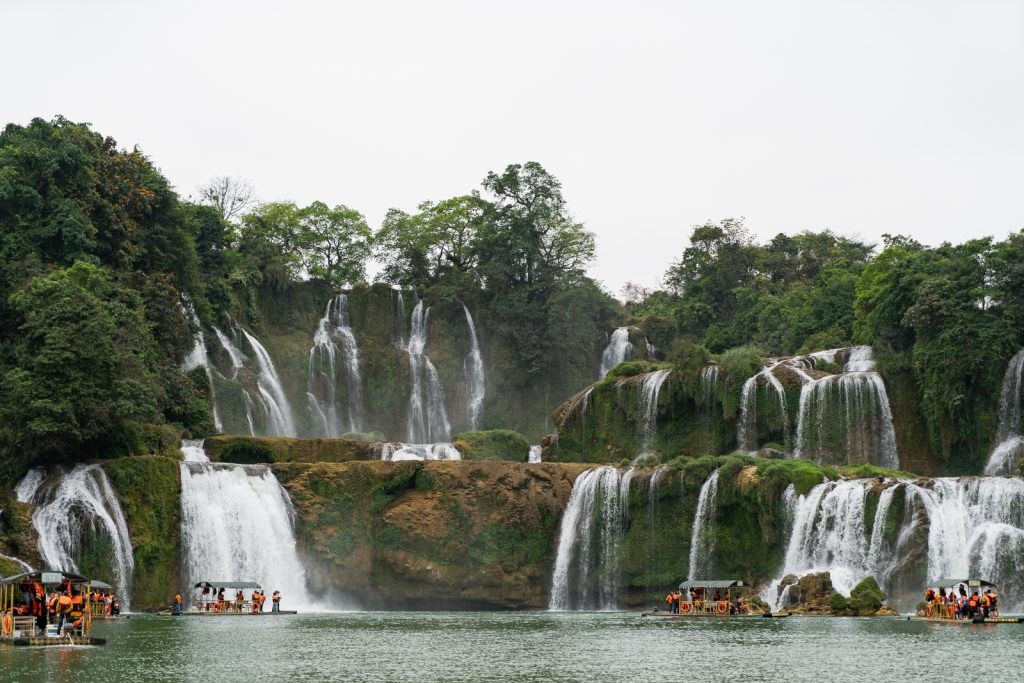 Ban Gioc Waterfall | Northern Vietnam Motorbike | Cao Bang Vietnam
Ban Gioc Waterfall | Northern Vietnam Motorbike | Cao Bang Vietnam
2.2. Route 2: Cao Bang to Ha Giang via DT206 and QL34
- Description: A longer but potentially less crowded route that offers a different perspective on the region’s beauty.
- Road Conditions: DT206 can be more challenging with narrower roads and varying conditions. QL34 is generally better maintained.
- Estimated Travel Time: Approximately 6-8 hours, depending on road conditions and stops.
- Key Highlights: Experiencing the less-traveled areas of both provinces, offering a more authentic view of rural life.
2.3. Route 3: Cao Bang to Ha Giang via QL3 and QL2
- Description: This route involves traveling further south before heading north towards Ha Giang, providing a glimpse into other regions.
- Road Conditions: QL3 and QL2 are major national highways and generally in good condition.
- Estimated Travel Time: Approximately 7-9 hours, making it the longest option.
- Key Highlights: Suitable for those interested in seeing more of the Vietnamese countryside beyond the immediate Cao Bang and Ha Giang area.
2.4. Route Comparison Table
| Route | Road Conditions | Estimated Travel Time | Key Highlights |
|---|---|---|---|
| Cao Bang to Ha Giang via QL4C | Generally well-maintained, winding roads | 5-7 hours | Passing through scenic Meo Vac |
| Cao Bang to Ha Giang via DT206 and QL34 | DT206 challenging, QL34 better | 6-8 hours | Less-traveled areas, authentic rural life |
| Cao Bang to Ha Giang via QL3 and QL2 | Major highways, generally in good condition | 7-9 hours | Glimpse into Vietnamese countryside beyond Cao Bang/Ha Giang |
3. Motorbike Travel: Advantages, Disadvantages, and Safety Tips
Motorbike travel between Cao Bang and Ha Giang is a popular choice for adventurous tourists seeking freedom and flexibility. While it offers unique advantages, it also comes with challenges and potential risks. Understanding these factors and following safety guidelines is crucial for a safe and enjoyable journey. SIXT.VN advises all motorbike travelers to prioritize safety and be well-prepared for the road conditions.
3.1. Advantages of Motorbike Travel
- Flexibility: Motorbikes allow you to explore at your own pace, stopping at scenic spots and small villages along the way.
- Immersive Experience: You’re more connected to the landscape and local culture, feeling the wind and experiencing the sights and sounds up close.
- Access to Remote Areas: Motorbikes can navigate narrow roads and rough terrain that larger vehicles can’t access.
- Cost-Effective: Renting a motorbike is often cheaper than hiring a private car or taking a tour.
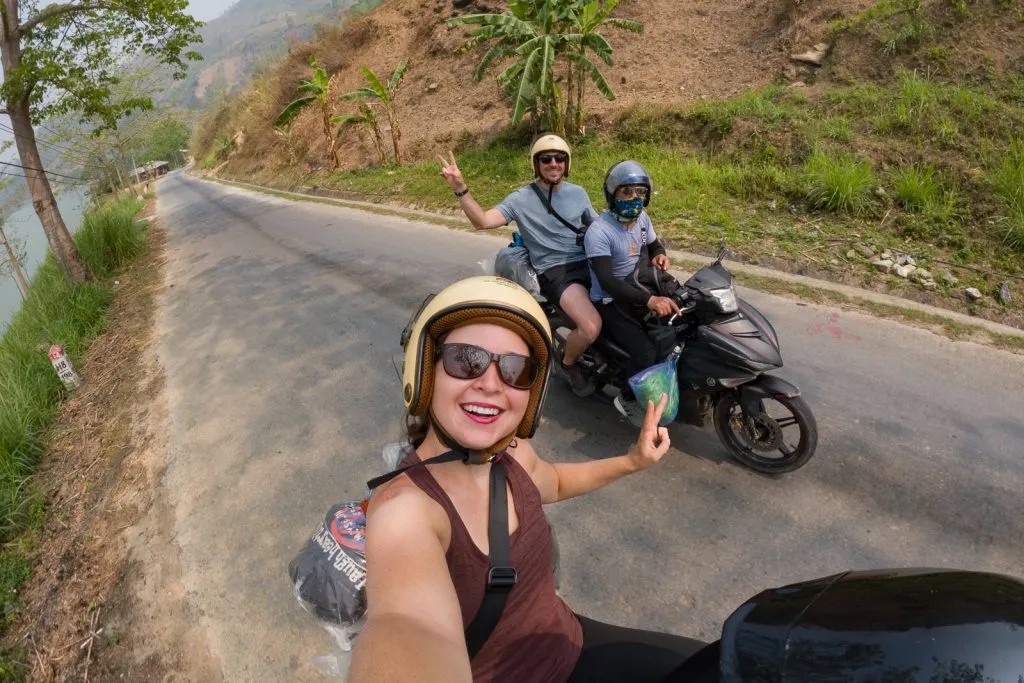 Northern Vietnam Motorbike
Northern Vietnam Motorbike
3.2. Disadvantages and Challenges
- Safety Risks: The winding mountain roads can be dangerous, especially in wet conditions or for inexperienced riders.
- Weather Dependence: Rain, fog, or extreme heat can make riding uncomfortable and hazardous.
- Physical Demands: Long hours on a motorbike can be tiring, requiring good physical stamina.
- Luggage Limitations: Limited space for luggage means you need to pack light.
- Legal Requirements: Understanding and adhering to local driving laws is essential.
3.3. Essential Safety Tips
- Wear a Quality Helmet: Always wear a helmet that fits properly and meets safety standards.
- Check the Bike: Before setting off, inspect the motorbike for any mechanical issues.
- Drive Defensively: Be aware of other vehicles, pedestrians, and road hazards.
- Take Breaks: Stop regularly to rest and avoid fatigue.
- Stay Hydrated: Drink plenty of water, especially in hot weather.
- Inform Someone of Your Plans: Let a friend or family member know your route and expected arrival time.
- Consider Travel Insurance: Ensure you have travel insurance that covers motorbike accidents.
- Obey Local Laws: Be aware of and adhere to local traffic laws and regulations.
3.4. Recommended Motorbikes
Semi-Automatic Motorbikes:
- Honda Wave Alpha: A reliable and fuel-efficient semi-automatic motorbike, ideal for beginners and those looking for an economical option.
- Yamaha Sirius: Similar to the Honda Wave Alpha, the Yamaha Sirius offers a comfortable ride and is easy to handle, making it suitable for less experienced riders.
Manual Motorbikes:
- Honda XR150: Known for its durability and ability to handle rough terrain, making it suitable for experienced riders tackling challenging roads.
- Honda Winner X: Combines sporty design with good performance, offering a more engaging riding experience for those comfortable with manual motorbikes.
Scooters:
- Honda Air Blade: A popular choice in Vietnam, known for its smooth ride, ample storage space, and modern features. However, it’s important to note that scooters may not be as suitable for very steep or rugged terrain compared to manual or semi-automatic motorbikes.
- Yamaha Grande: This scooter offers a blend of style and functionality, providing a comfortable ride and sufficient power for city and highway use.
4. Private Car and Bus/Van Options: Comfort vs. Cost
When traveling between Cao Bang and Ha Giang, private cars and buses/vans offer distinct advantages in terms of comfort and cost. Choosing the right option depends on your budget, travel style, and the level of convenience you desire. SIXT.VN provides both private car and bus/van services tailored to your specific needs and preferences.
4.1. Private Car: Comfort and Convenience
-
Advantages:
- Comfort: Enjoy a relaxed and comfortable ride with air conditioning and ample space.
- Flexibility: Customize your itinerary, stop at scenic spots, and explore at your own pace.
- Convenience: Door-to-door service eliminates the hassle of public transportation.
- Privacy: Ideal for families, groups, or those seeking a more private experience.
-
Disadvantages:
- Cost: Generally more expensive than bus/van options.
- Limited Availability: May require booking in advance, especially during peak season.
4.2. Bus/Van: Budget-Friendly Travel
-
Advantages:
- Cost-Effective: More affordable than private car options.
- Accessibility: Widely available with frequent departures between major towns.
-
Disadvantages:
- Limited Flexibility: Fixed routes and schedules restrict your ability to explore.
- Less Comfortable: Can be crowded and less comfortable than private cars.
- Longer Travel Time: Multiple stops can extend the journey.
- Less Privacy: Shared travel experience may not appeal to everyone.
4.3. Comparing Comfort and Cost
| Feature | Private Car | Bus/Van |
|---|---|---|
| Comfort | High: Air conditioning, ample space | Low: Can be crowded, less comfortable |
| Flexibility | High: Customizable itinerary, stops at will | Low: Fixed routes and schedules |
| Convenience | High: Door-to-door service | Low: Requires travel to/from bus stations |
| Privacy | High: Private experience | Low: Shared travel experience |
| Cost | High: More expensive | Low: More affordable |
| Travel Time | Shorter travel time | Longer travel time |
4.4. Recommendations for Each Option
-
Choose Private Car If:
- You value comfort and convenience above cost.
- You’re traveling with family or a group.
- You want the flexibility to customize your itinerary.
-
Choose Bus/Van If:
- You’re on a tight budget.
- You don’t mind sharing the ride with others.
- You’re comfortable with fixed routes and schedules.
- You are okay with public transport to save travel costs.
5. Key Attractions Along the Way: Planning Your Stops
Traveling between Cao Bang and Ha Giang offers the opportunity to explore numerous key attractions along the way. Planning your stops in advance ensures you make the most of your journey and experience the best of what these regions have to offer. SIXT.VN recommends incorporating these attractions into your itinerary for a memorable trip.
5.1. Cao Bang Attractions
- Ban Gioc Waterfall: A majestic waterfall on the border with China, surrounded by stunning natural scenery.
- Pac Bo Cave: A historical site where Ho Chi Minh returned to Vietnam after 30 years in exile.
- Nguom Ngao Cave: A large and impressive cave system with unique rock formations.
- Thang Hen Lake: A beautiful lake surrounded by mountains, perfect for a relaxing boat trip.
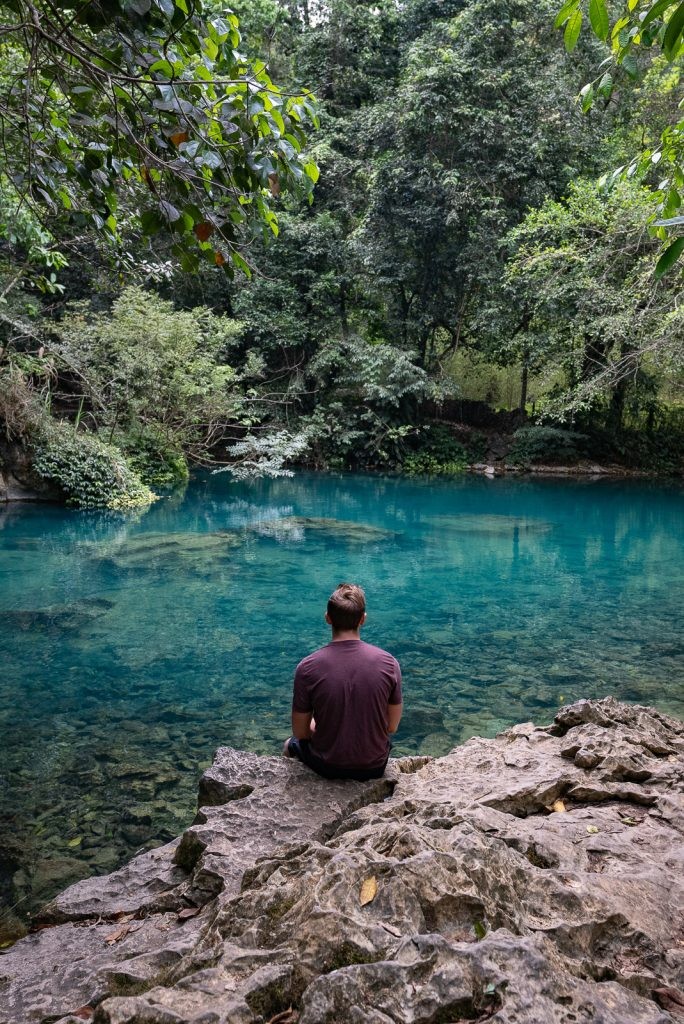 Pac Bo Cave | Cao Bang Vietnam
Pac Bo Cave | Cao Bang Vietnam
5.2. Ha Giang Attractions
- Dong Van Karst Plateau Geopark: A UNESCO World Heritage site with dramatic landscapes, winding roads, and ethnic minority villages.
- Ma Pi Leng Pass: One of the most scenic mountain passes in Vietnam, offering breathtaking views of the Tu San Canyon.
- Lung Cu Flag Tower: The northernmost point of Vietnam, with panoramic views of the surrounding area.
- Hoang Su Phi Rice Terraces: Stunning terraced rice fields that cascade down the mountainsides.
5.3. Attractions Along the Routes
- Meo Vac: A small town known for its Sunday market and stunning mountain scenery.
- Yen Minh: A quiet town with a relaxed atmosphere, surrounded by rice paddies and rolling hills.
- Tam Son: Known for its twin mountains, often referred to as the Fairy Breast Mountains.
- Quan Ba Heaven Gate: Offers panoramic views of the surrounding valleys and mountains.
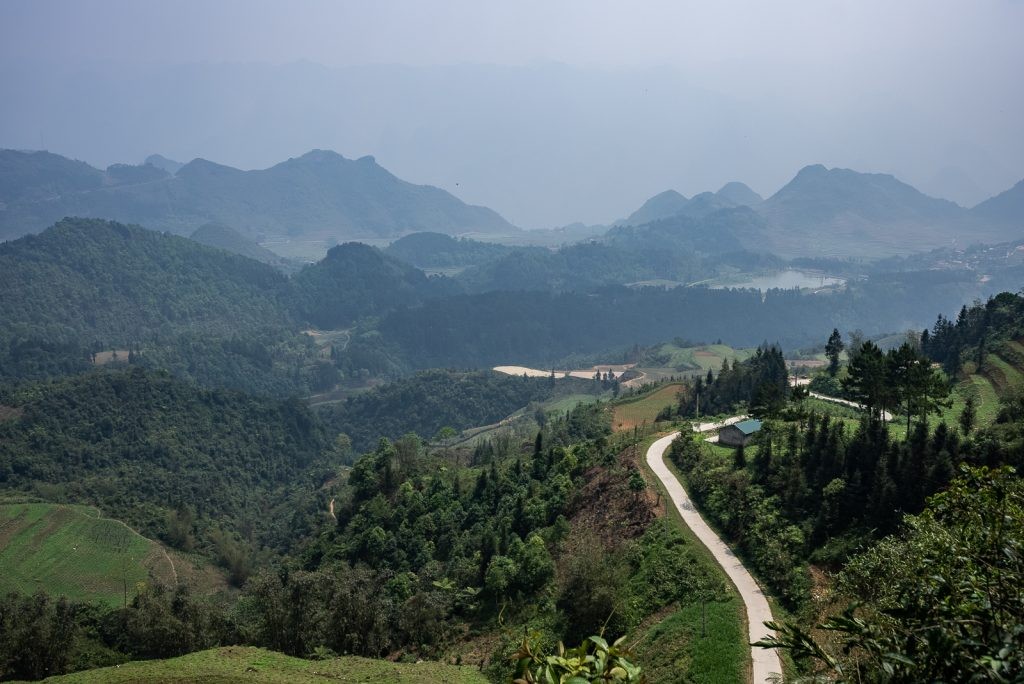 Heavens Gate | Northern Vietnam Motorbike
Heavens Gate | Northern Vietnam Motorbike
5.4. Sample Itinerary with Key Attractions
| Day | Location | Activity |
|---|---|---|
| Day 1 | Cao Bang | Visit Ban Gioc Waterfall and Pac Bo Cave |
| Day 2 | Cao Bang to Meo Vac | Drive through scenic routes, stop at local markets, and enjoy local cuisine |
| Day 3 | Meo Vac to Dong Van | Explore Ma Pi Leng Pass and visit local ethnic villages |
| Day 4 | Dong Van to Ha Giang | Visit Lung Cu Flag Tower and explore Dong Van Karst Plateau Geopark |
6. Accommodation Options: From Homestays to Hotels
Finding the right accommodation is crucial for a comfortable and enjoyable trip between Cao Bang and Ha Giang. The region offers a range of options, from budget-friendly homestays to more luxurious hotels. Understanding the available choices helps you plan your stay according to your preferences and budget. SIXT.VN offers recommendations and booking assistance for accommodations in both provinces.
6.1. Homestays: Immersive Cultural Experience
-
Advantages:
- Authenticity: Experience local culture and hospitality firsthand.
- Affordability: Generally more budget-friendly than hotels.
- Local Cuisine: Enjoy home-cooked meals prepared with fresh, local ingredients.
- Personal Interaction: Opportunity to interact with local families and learn about their way of life.
-
Considerations:
- Basic Amenities: May offer fewer amenities than hotels.
- Language Barrier: Communication can be challenging if you don’t speak the local language.
-
Recommendations:
- Me Farmstay (Cao Bang): Offers a unique experience with farm activities and local culture.
- Duy Tho Homestay (Ba Be Lake): Provides a tranquil setting by the lake.
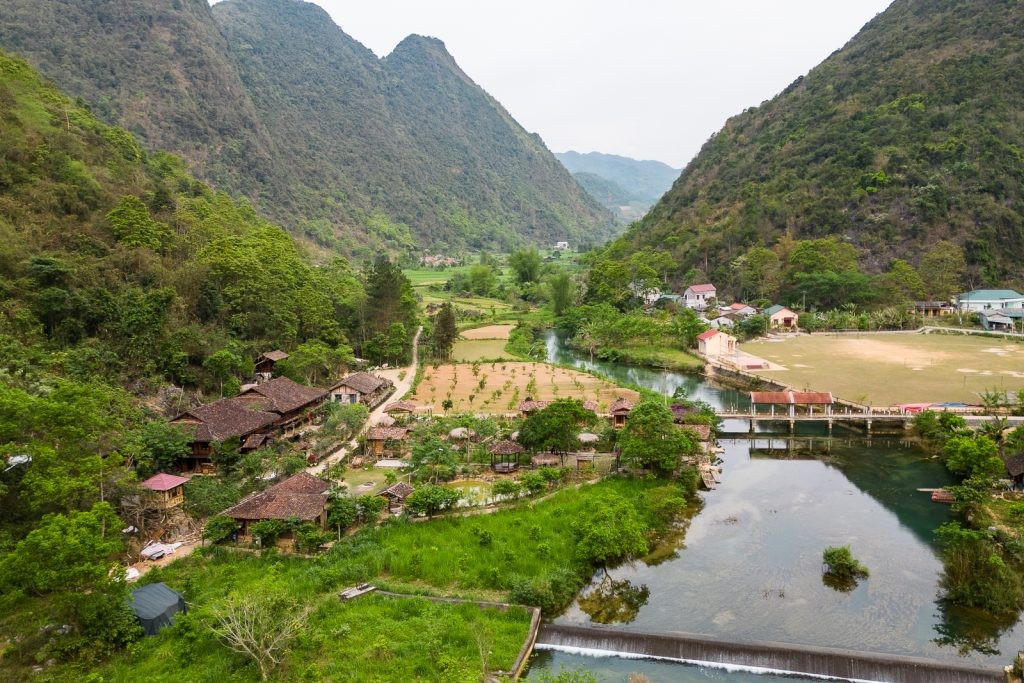 Me Farmstay Cao Bang Vietnam
Me Farmstay Cao Bang Vietnam
6.2. Hotels: Comfort and Convenience
-
Advantages:
- Amenities: Offer a wider range of amenities, such as air conditioning, private bathrooms, and on-site restaurants.
- Convenience: Provide services like laundry, tour bookings, and transportation assistance.
- Language Support: Staff often speak English, making communication easier.
-
Considerations:
- Higher Cost: Generally more expensive than homestays.
- Less Authentic: May offer a less immersive cultural experience.
-
Recommendations:
- Sun Ha Giang Hotel (Ha Giang): Offers comfortable rooms and a central location.
- Khách Sạn Mai Đào (Meo Vac): Provides comfortable accommodation in Meo Vac.
6.3. Guesthouses: A Balance of Cost and Comfort
-
Advantages:
- Affordable: Mid-range pricing between homestays and hotels.
- Basic Amenities: Offer private rooms and essential amenities.
- Local Experience: Often family-run, providing a more personal touch.
-
Considerations:
- Limited Services: May offer fewer services than hotels.
-
Recommendations:
- Be’s Home (Ha Giang): A hostel with private rooms, offering friendly service.
- Thái Tâm Motel (Dong Van): Provides basic but clean accommodation in Dong Van.
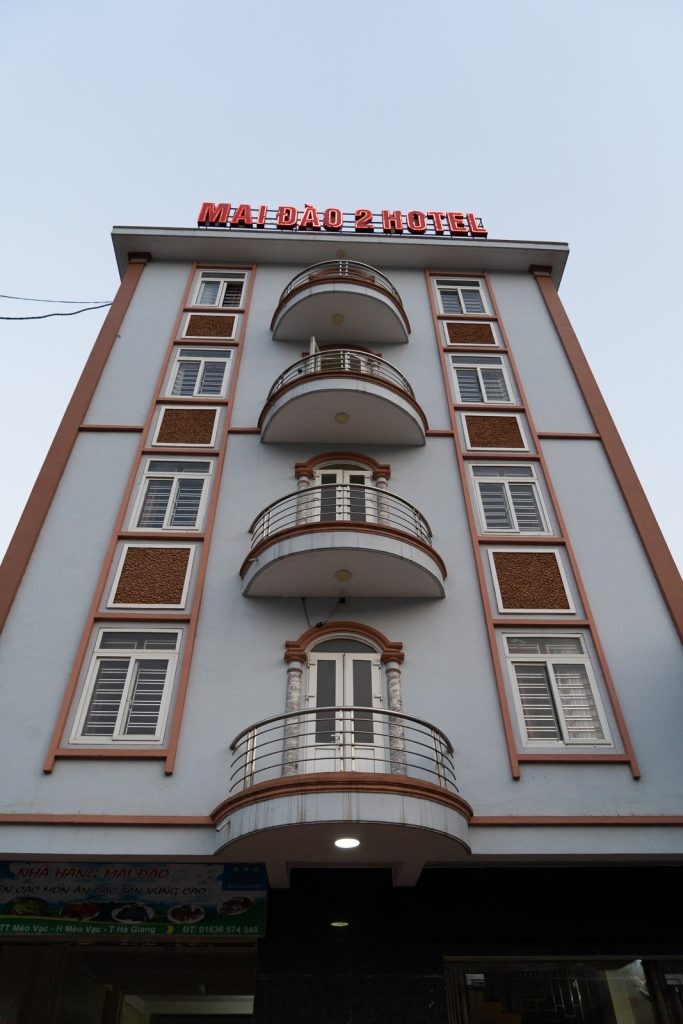 Ha Giang Loop Tour | Northern Vietnam Motorbike
Ha Giang Loop Tour | Northern Vietnam Motorbike
6.4. Booking Tips
- Book in Advance: Especially during peak season, to secure your preferred accommodation.
- Read Reviews: Check online reviews to get insights from other travelers.
- Consider Location: Choose accommodation that is conveniently located for your planned activities.
- Check Amenities: Ensure the accommodation offers the amenities you need, such as Wi-Fi or air conditioning.
7. Best Time to Travel: Weather and Seasonal Considerations
Choosing the best time to travel between Cao Bang and Ha Giang is crucial for an enjoyable and safe trip. Weather conditions can significantly impact road conditions, visibility, and overall travel experience. Understanding the seasonal variations helps you plan accordingly. SIXT.VN provides up-to-date weather information and travel recommendations to help you make the best choice.
7.1. Spring (March to May): Pleasant and Blooming
-
Weather: Mild temperatures with occasional rain.
-
Advantages:
- Blooming flowers and lush greenery create beautiful landscapes.
- Pleasant temperatures for outdoor activities.
-
Considerations:
- Occasional rain can make roads slippery.
-
Recommendation:
- Ideal for those who enjoy moderate weather and scenic beauty.
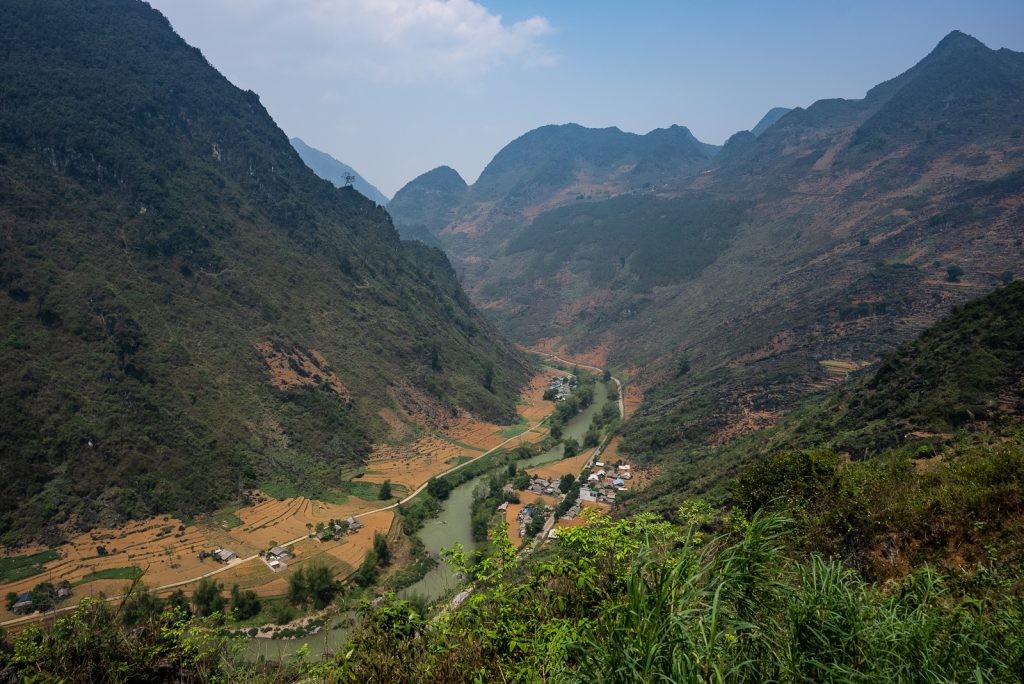 Ha Giang Loop Tour | Northern Vietnam Motorbike
Ha Giang Loop Tour | Northern Vietnam Motorbike
7.2. Summer (June to August): Rainy and Lush
-
Weather: Hot and humid with frequent heavy rain.
-
Advantages:
- Lush, green landscapes.
-
Considerations:
- Heavy rain can cause landslides and make roads dangerous.
- High humidity can be uncomfortable.
-
Recommendation:
- Not recommended for inexperienced motorbike riders due to hazardous conditions.
7.3. Fall (September to November): Golden Rice Fields
-
Weather: Dry and sunny with cooler temperatures.
-
Advantages:
- Golden rice fields create stunning landscapes.
- Ideal weather for outdoor activities.
-
Considerations:
- Can be crowded due to peak tourist season.
-
Recommendation:
- Best time to visit for scenic beauty and comfortable weather.
7.4. Winter (December to February): Cold and Misty
-
Weather: Cold temperatures with occasional frost and fog.
-
Advantages:
- Clear skies and crisp air.
-
Considerations:
- Cold weather can be uncomfortable for riding.
- Fog can reduce visibility on mountain roads.
- Possible icy roads.
-
Recommendation:
- Suitable for experienced travelers who are prepared for cold weather.
7.5. Monthly Weather Averages Table
| Month | Temperature (°C) | Rainfall (mm) | Weather Conditions |
|---|---|---|---|
| March | 18-25 | 50-80 | Mild, occasional rain, blooming flowers |
| April | 20-27 | 80-120 | Warm, increased rainfall, lush greenery |
| May | 23-30 | 150-200 | Hot, frequent rain, high humidity |
| June | 25-32 | 200-250 | Very hot, heavy rain, potential for landslides |
| July | 25-32 | 200-250 | Very hot, heavy rain, potential for landslides |
| August | 24-31 | 180-230 | Hot, heavy rain, potential for landslides |
| September | 23-30 | 100-150 | Warm, decreasing rainfall, golden rice fields |
| October | 20-27 | 50-100 | Mild, dry, golden rice fields |
| November | 18-25 | 30-50 | Cool, dry, clear skies |
| December | 15-22 | 20-40 | Cold, dry, occasional frost |
| January | 13-20 | 10-30 | Very cold, dry, potential for fog |
| February | 14-21 | 15-35 | Cold, increasing temperatures, potential for drizzle |
8. Cultural Considerations: Respecting Local Customs
Traveling between Cao Bang and Ha Giang offers the opportunity to immerse yourself in the rich and diverse cultures of Vietnam’s ethnic minority groups. Respecting local customs and traditions is essential for a meaningful and positive travel experience. Understanding these cultural nuances enhances your interactions and fosters goodwill with the local communities. SIXT.VN encourages all travelers to be mindful and respectful of the local culture.
8.1. Ethnic Diversity
- Cao Bang: Home to Tay, Nung, Dao, and Hmong ethnic groups, each with unique traditions, languages, and costumes.
- Ha Giang: Predominantly Hmong, but also includes Dao, Tay, Nung, and Lo Lo communities.
8.2. Dress Code
- Modesty: Dress modestly when visiting temples, pagodas, or local homes.
- Appropriate Attire: Avoid wearing revealing clothing in rural areas.
- Footwear: Remove shoes before entering someone’s home or a religious site.
8.3. Interactions with Locals
- Greetings: Greet people with a polite nod or a smile.
- Language: Learn a few basic Vietnamese phrases to show respect.
- Photography: Ask for permission before taking photos of people, especially in rural areas.
8.4. Dining Etiquette
- Sharing: Meals are often shared family-style.
- Chopsticks: Use chopsticks to eat and avoid sticking them upright in your rice bowl.
- Respect for Elders: Show respect to elders by allowing them to serve themselves first.
- Happy Water: Be mindful of your consumption.
8.5. Gifts and Donations
- Gifts: Small gifts, like pens or notebooks, are appreciated when visiting schools or local communities.
- Money: Avoid giving money directly to children; instead, support local businesses or community projects.
8.6. Dos and Don’ts Table
| Do | Don’t |
|---|---|
| Dress modestly when visiting temples or local homes | Wear revealing clothing in rural areas |
| Greet people with a polite nod or smile | Take photos of people without asking for permission |
| Learn a few basic Vietnamese phrases | Stick chopsticks upright in your rice bowl |
| Support local businesses or community projects | Give money directly to children |
| Remove shoes before entering someone’s home or religious site | Show disrespect to elders during meals |
9. Budgeting Your Trip: Costs and Money-Saving Tips
Planning a trip between Cao Bang and Ha Giang requires careful budgeting to ensure you can experience the best of these regions without overspending. Understanding the typical costs and implementing money-saving strategies can help you optimize your travel budget. SIXT.VN provides tips and advice to help you manage your expenses effectively.
9.1. Typical Costs
-
Transportation:
- Motorbike Rental: 150,000 – 300,000 VND per day
- Private Car Hire: 800,000 – 1,500,000 VND per day
- Bus/Van Ticket: 200,000 – 400,000 VND per trip
-
Accommodation:
- Homestay: 100,000 – 300,000 VND per night
- Hotel: 300,000 – 800,000 VND per night
-
Food:
- Local Restaurant: 50,000 – 150,000 VND per meal
- Street Food: 20,000 – 50,000 VND per snack
-
Activities:
- Entrance Fees: 20,000 – 50,000 VND per site
- Boat Trips: 100,000 – 200,000 VND per trip
-
Miscellaneous:
- Fuel: 50,000 – 100,000 VND per day (motorbike)
- Tips: 5-10% for good service
9.2. Money-Saving Tips
- Travel in the Off-Season: Prices for accommodation and transportation are often lower during the off-season.
- Eat Local: Dine at local restaurants and street food stalls to save on food costs.
- Use Public Transportation: Opt for buses or vans instead of private cars whenever possible.
- Stay in Homestays: Choose homestays over hotels for a more affordable accommodation option.
- Bargain: Negotiate prices at markets and with vendors, especially for souvenirs.
- Pack Snacks: Bring your own snacks and drinks to avoid buying them at touristy areas.
- Free Activities: Take advantage of free activities, such as hiking and exploring natural attractions.
- Avoid Tourist Traps: Steer clear of tourist traps, which often charge inflated prices.
9.3. Sample Budget Table
| Expense | Budget per Day (VND) | Notes |
|---|---|---|
| Transportation | 200,000 – 500,000 | Motorbike rental or bus/van ticket |
| Accommodation | 100,000 – 300,000 | Homestay or budget hotel |
| Food | 150,000 – 300,000 | Local restaurants and street food |
| Activities | 50,000 – 150,000 | Entrance fees and boat trips |
| Miscellaneous | 50,000 – 100,000 | Fuel, tips, and souvenirs |
| Total | 550,000 – 1,350,000 | Varies depending on travel style and choices |
9.4. Currency and Payment
- Currency: The official currency of Vietnam is the Vietnamese Dong (VND).
- Exchange Rates: Check current exchange rates before your trip.
- Payment Methods: Cash is widely accepted, especially in rural areas. Credit cards are accepted at larger hotels and restaurants.
- ATMs: ATMs are available in major towns, but it’s a good idea to carry enough cash for smaller villages.
10. Staying Connected: Internet and Communication
Maintaining connectivity during your trip between Cao Bang and Ha Giang is essential for navigation, communication, and staying informed. Understanding the available options for internet access and communication helps you plan effectively. SIXT.VN recommends these solutions to stay connected on your journey.
10.1. Mobile Data
- SIM Cards: Purchase a local SIM card from a Vietnamese mobile operator for affordable data.
- eSIMs: Use eSIMs from Airalo.
- Coverage: 4G coverage is generally good in major towns, but can be limited in remote areas.
10.2. Wi-Fi
- Availability: Wi-Fi is available at most hotels, guesthouses, and cafes in larger towns.
- Reliability: Wi-Fi can be unreliable in some areas, especially during peak hours.
10.3. Communication Apps
- WhatsApp: Widely used for messaging and calls in Vietnam.
- Viber: Another popular messaging app.
- Zalo: A local messaging app popular in Vietnam.
10.4. Language Translation Apps
- Google Translate: Download Vietnamese for offline use to translate text and speech.
- iTranslate: Another useful translation app.
10.5. Navigation Apps
- Google Maps: Download offline maps for navigation in areas with limited internet access.
- Maps.me: A useful app for offline maps and navigation.
10.6. Communication Tips
- Learn Basic Phrases: Learn a few basic Vietnamese phrases to communicate with locals.
- Use Visual Aids: Use gestures or visual aids to communicate if there is a language barrier.
- Stay Charged: Carry a portable charger to keep your devices powered up.
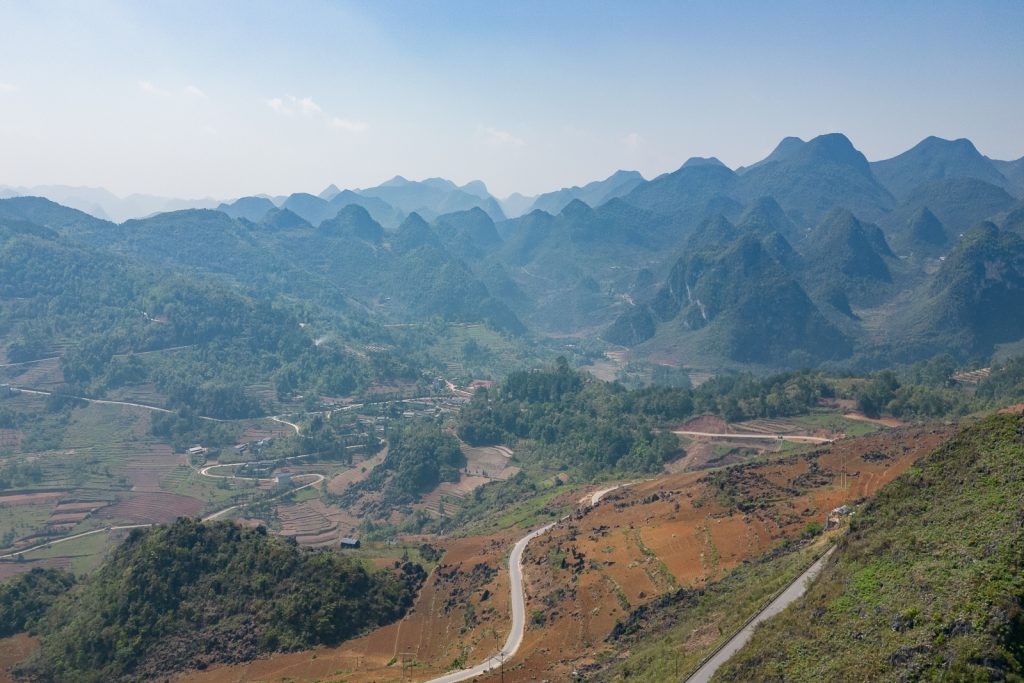 Ha Giang Loop Tour | Northern Vietnam Motorbike
Ha Giang Loop Tour | Northern Vietnam Motorbike
10.7. Emergency Communication
- Local Emergency Numbers:
- Police: 113
- Fire: 114
- Ambulance: 115
- Contact Your Embassy: Keep contact information for your embassy or consulate handy.
FAQ: Frequently Asked Questions
Q1: Is it safe to travel between Cao Bang and Ha Giang?
Yes, traveling between Cao Bang and Ha Giang is generally safe. However, it’s essential to be aware of road conditions and drive carefully, especially on motorbikes.
Q2: What is the best mode of transportation for this route?
The best mode of transportation depends on your preferences and budget. Motorbikes offer flexibility, while private cars provide comfort. Buses/vans are a budget-friendly option.
Q3: How long does it take to travel between Cao Bang and Ha Giang?
The travel time varies depending on the route and mode of transportation, ranging from 5 to 9 hours.
Q4: What are the must-see attractions along the way?
Must-see attractions include Ban Gioc Waterfall, Ma Pi Leng Pass, Lung Cu Flag Tower, and Dong Van Karst Plateau Geopark.
Q5: What is the best time to visit Cao Bang and Ha Giang?
The best time to visit is during the fall (September to November) for pleasant weather and golden rice fields.
Q6: How much does it cost to travel between Cao Bang and Ha Giang?
The cost varies depending on your choices, but a budget of 550,000 – 1,350,000 VND per day is a good estimate.
Q7: Can I use my credit card in Cao Bang and Ha Giang?
Credit cards are accepted at larger hotels and restaurants, but cash is preferred in rural areas.
Q8: Do I need a visa to visit Vietnam?
Most foreign visitors need a visa to enter Vietnam. Check visa requirements based on your nationality.
Q9: What should I pack for this trip?
Pack layers, rain gear, comfortable shoes, and essential toiletries.
Q10: Is it necessary to book accommodations in advance?
Booking accommodations in advance is recommended, especially during peak season.
SIXT.VN makes your dream trip a reality by offering professional advice and dependable services, optimizing your Vietnam travel experiences. Contact SIXT.VN at Address: 260 Cau Giay, Hanoi, Vietnam, Hotline/Whatsapp: +84 986 244 358, or visit the website at SIXT.VN to discover more about travel advice, airport transfers, hotel bookings, travel arrangements, airline tickets, and Hanoi excursions. Let us help you organize your travel right now to discover Northern Vietnam’s hidden treasures without any logistical difficulties.



